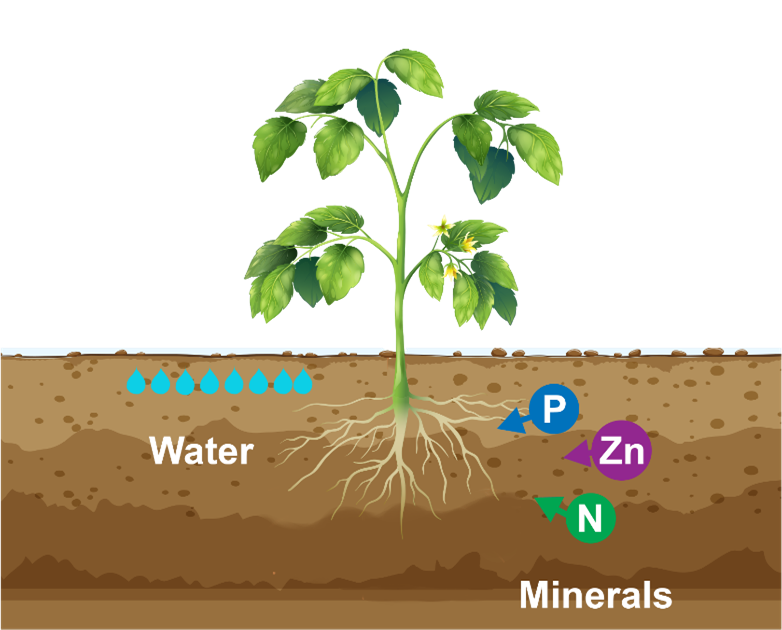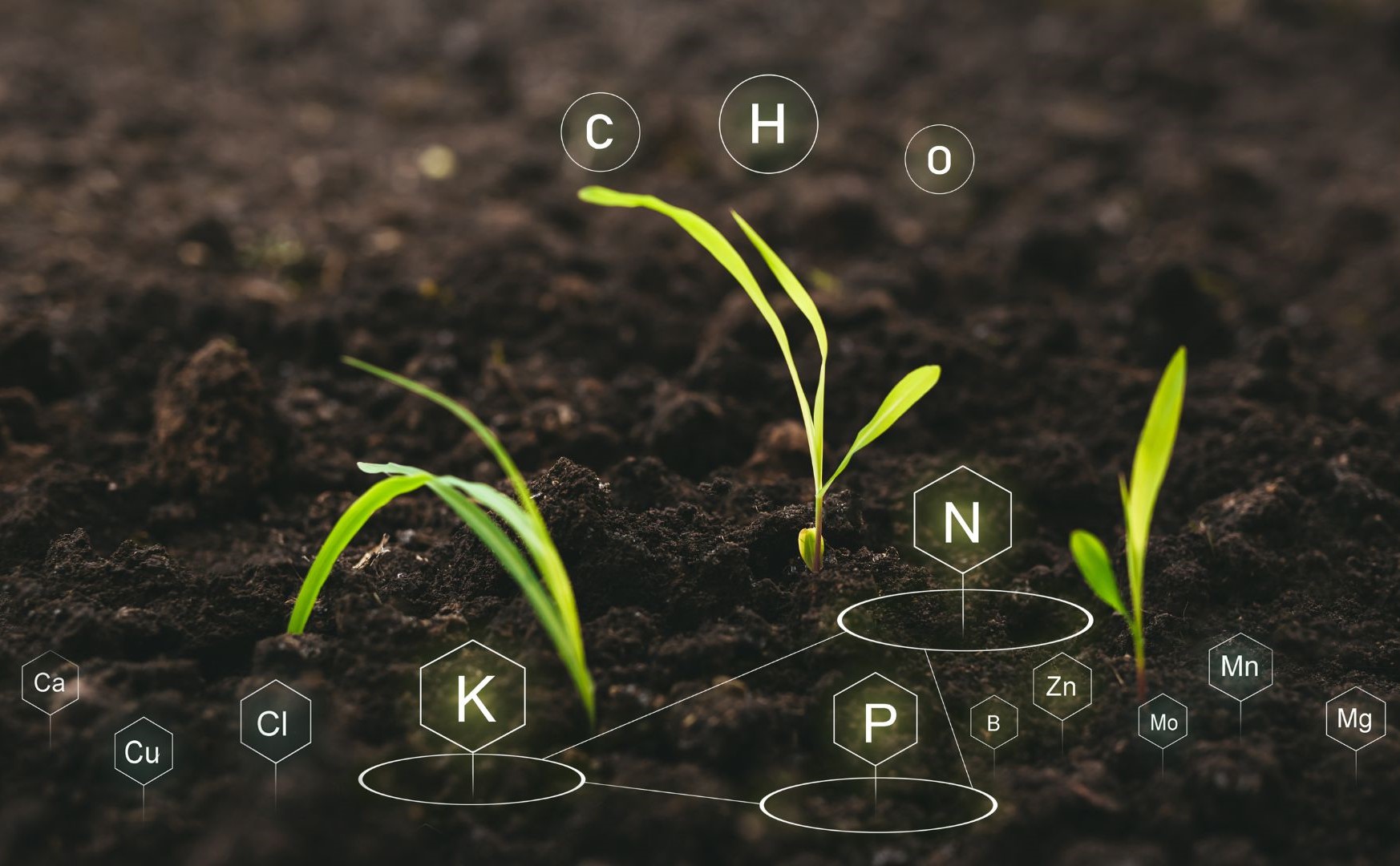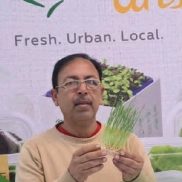Nutrient Mobility in Soil and Plants
Nutrient mobility refers to the ability of nutrients to move in a particular environment. Understanding nutrient mobility helps in identifying nutrient deficiencies and pinpointing their underlying causes. The extent of nutrient mobility differs depending on whether the nutrient is situated within a plant or in the soil.

Figure 1
The plant nutrients are categorized into Macro and microelements, where the Macro elements are further categorized into:
- Primary elements
- Secondary elements.
Plants need eighteen naturally occurring elements for their growth and production. Among these elements, carbon (C), hydrogen (H), and oxygen (O) play a vital role in forming the physical structure of the plant. These elements are acquired from the atmosphere (in the form of CO2) and water (as H2O) and serve as the fundamental building blocks for carbohydrates like sugars and starch. These carbohydrates not only contribute to the structural integrity of cell walls, stems, and leaves but also serve as sources of energy for the plant itself and for organisms that feed on the plant.”
Each element has its own specific function in plants, but quantities needed differ. For example, macroelements (macronutrients) are required in larger amounts than microelements (micronutrients).
- Structural elements: C, H, O
- Primary Macro elements: N, P, K
- Secondary Macro elements: Ca, Mg, S
- Microelements: Fe, B, Cu, Cl, Mn, Mo, Zn, Co, Ni
All those nutrients should be in ionic form, either in the soil or in a nutrient solution. Ions are simply the atomic or molecule form having +ve or –ve charge. As we know, the positive attracts the negative, and the same charge elements will repel each other; this power of charge represents the strength of the element. The positive ions are known as Cation, while negative ions are Anions. The anions want to disperse themselves to even concentrations, so they move from higher concentrations to lower concentrations.
As we look at the soil structure, it’s a composition of particles; those particles attract the positive ions (+Ve), repel the Negative ions (-ve), and float freely in the water. This attraction of Cation by the soil particles is called Cation Exchange Capacity (CEC), which measures the number of cations that can be retained by the soil particles. The higher the CEC, the more Cation Nutrients can be stored in the soil. As a result, the higher CEC soils can become more nutrient-rich; also, keep in mind the soil composition is diverse and varies among different soil types.
The picture shows that plants absorb nutrients from the soil through the root system; those nutrients should be in solution form around the root zone area. The availability of those nutrients to the plants depends on the pH of the soil or soil solution/nutrient solution. Most nutrients are available to plants in soils with a pH of 5.5 to 6.5.
The interaction of nutrient availability and binding in the soil is shown in Fig (2).
Figure 2. The availability of soil-applied nutrients is dependent on soil pH. Credit: Tonya R. Weeks, UF/IFAS CREC – Fig 2
Most of the micronutrients form bonds with the soil, becoming immobile and inaccessible for plant absorption when the soil pH is high. Similar is the case in soils with very low pH, where most macro- and secondary nutrients also become inaccessible for plant uptake. The objective is to maintain an optimal soil pH range that facilitates plant nutrient absorption.
As the plants uptake nutrients from the soil, some are mobile in the plants, while others are immobile. The mobility (movement) power on nutrients can be affected by many factors, including the parental rock material (solubility), particle size, humus and water content, pH, aeration, area, the rhizobia of the root systems, and mycorrhizal development.
The study and knowledge of nutrient mobility in soil and plant is very effective in understanding nutrient deficiencies and provides an opportunity to correct them on time. Biological, chemical, and physical forces can change the state of those elements and make them more or less mobile. Since immobile elements do not move easily within the plant, deficiency symptoms can appear in new vegetation. When mobile elements become limiting, they can be scavenged from older growth and moved to where they are most needed, causing deficiency symptoms in older leaves. Most nutrient deficiencies only appear once the plant is at a peak growth period or at high nutrient demand, such as fruit set.
When scouting the plants regarding the nutrient deficiencies, we should never forget the following points.
The plant should be divided into three parts (as shown in Fig 3):
- Older growth
- Middle growth
- New growth

Fig 3 Generalized diagram showing the portion of the plant where nutrient deficiency symptoms are first observed. Courtesy of the 4R Plant Nutrition Manual, IPNI 2012.)
Having a clear knowledge of which element is mobile or immobile in the plants is a critical factor for knowing about the nutrient deficiency symptoms as well as decision-making for the efficient management of plant fertilizer and nutrients.
Understand the 4 R strategy.
When we talk about proper and efficient nutrient management and application, we consider the 4-R strategy, the 4 major factors:
1) right source
2) right amount
3) right place
4) right time
By considering these factors, we can ensure sufficient nutritional support for crop growth while reducing the risk of nutrient loss in the environment.
The simple way to understand the 4 R strategy is to imagine you are planning to grow crops or are already a farmer just brainstorming while standing in your field.
What is growing? —————–Crop / Plants
On what is growing? ————- soil (type of soil)
What do they need? ——————– Plants & Soil (Both)
From where? ————————- (sources to satisfy need –fertilizer)
How much is needed ——————– Amount of resource/input
When is it needed? ————————– Time (Crop stage)
This brainstorming will help you to find all the answers to making the best strategy for sustainable fertilizer management.
References & Resources
https://edis.ifas/article/abs.ufl.edu/publication/HS1373
https://nrcca.cals.cornell.edu/soilFertilityCA/CA1/CA1_print.html
https://www.sciencedirect.com/topics/agricultural-and-biological-sciences/nutrient-availability










































































